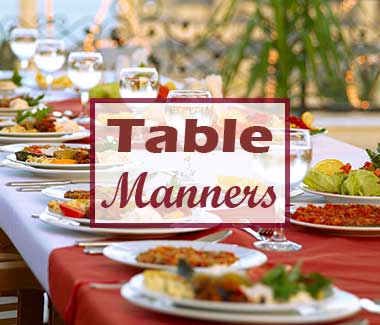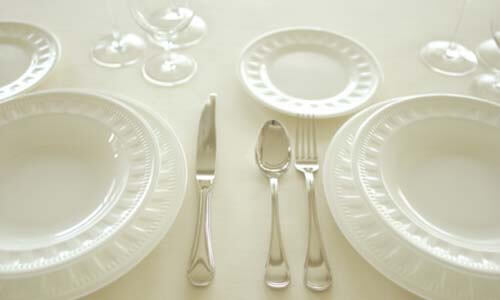South Korean Dining Etiquette
international dining etiquette
Dining etiquette for drinking. Because you must never pour your own drink, you must always be alert as to whether your neighbor's cup or glass needs refilling. If it is less than half full, it needs refilling; alternately, if yours is less than half full, your neighbor is obliged to refill it. If he or she does not, do not refill it yourself, for this will cause them to lose face; instead, diplomatically indicate your need by pouring a little more drink into your neighbor's glass, even if it doesn’t really need it. When you pour for your neighbor or pass plates of food to him or her, you should use the "elbow support" gesture.
In South Korea, there is a twist on the pouring rule. At traditional and family feasts, after the first glass is filled by your neighbor and then drained by you, South Koreans often refill their own glass, but pass it to the person sitting on their right. Of course, your neighbor on the left has done the same with their glass and given it to you. Then, after you drink, you refill the glass, and pass it again to the neighbor on your right, with everyone at the table doing the same thing. This is usually done during a series of toasts.
Dining etiquette for toasts. The toast in Korea is cangai, which means "bottoms up" or "drain the glass." If you are the honored guest you will be expected to make a toast, usually soon after the host does or at the end of the meal, just before everyone departs.
Table Manners
South Korea is one of the traditional chopstick cultures. Refer to the rules for using chopsticks on the Japanese dining etiquette page. Note, however, that Korean chopsticks are more like the rounded Chinese kind, as opposed to the square-sided Japanese chopsticks, and do not come attached (they do not require snapping apart).
Dining etiquette for using chopsticks in South Korea. Korean chopsticks are rarely presented in paper wrappers, so unless you have little ceramic chopstick rests, you need to rest the "mouth" end of your chopsticks alongside the plate, the idea also being that the food end of the chopsticks should never touch the table. Never place your chopsticks parallel to each other across the top of a rice bowl (this is considered to be very rude), and never place bits of unwanted food in a used rice bowl (also considered very rude). Use chopsticks-to eat soup (see the Japanese dining etiquette page for the proper technique), rice, peanuts, and practically every item on your plate, no matter how small, round, or difficult. Never use your fingers; always use your chopsticks. Also use your chopsticks to cut up pieces of food, if necessary; remember, the meat or fish is marinated before cooking, so it will be easy to break up the flesh with the chopsticks: there will be no need for knives.
Dining etiquette for eating rice. While rice is a staple, it is not necessary to eat every grain of rice in your bowl (and there are some Korean dishes where rice is served on the plate with the food); leaving some is fine. Also, a sauce may be mixed with the rice, and the main dish may be eaten with the rice, unlike the practice in Japan. In South Korea, it is not appropriate to hold the rice bowl up to your lips: you should keep the bowl down on the tabletop, if possible, which requires you to do some serious bending over in order to eat it (that's okay; raising the rice bowl is not).
Dining etiquette for communal dishes. Dishes may come with their own set of serving chopsticks, which are to be used by everyone, one person at a time, to serve themselves or their neighbor by picking out the food from the main service and placing it on their plate. You must never keep the serving chopsticks after using them; put them back on the main dish after you're done. But sometimes the dishes are presented without serving chopsticks at all. This means that you have to serve yourself with your own chopsticks
Dining etiquette for seating. The most honored position is at the middle of the table, with the second most important person seated next. This means that the host will sit at the middle of the table on one side, and the honored guest in the middle on the other side, opposite the host. The honored guest sits on the side of the table farthest from the door.
Dining etiquette for beginning to eat. In South Korea, it is expected that you wait until the senior person is served and begins to eat before you begin eating or drinking. Try to follow your colleagues' lead in when to drink, eat, or make a toast.
Dining etiquette in restaurants. You may be required to share a table. If so, do not force conversation; act as if you are seated at a private table your lead from their conversation.
Dining etiquette in the home. Remove your shoes. You will probably sit at a table or, more traditionally, on the floor in the middle of the room. Allow the more senior members of your party to enter rooms ahead of you.
Dining etiquette for paying the bill. Usually the one who does the inviting pays the bill, although the guest is expected to make an effort to pay. Sometimes other circumstances determine the payee (such as rank).
Dining etiquette for tipping. Tipping is not common in South Korea, but waiters do appreciate the equivalent of 5 percent or so.



